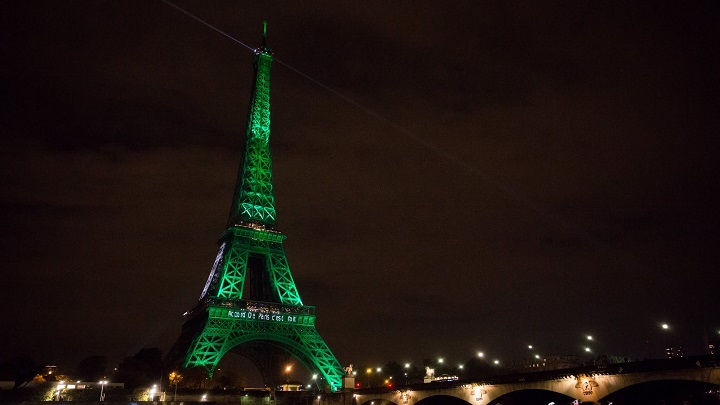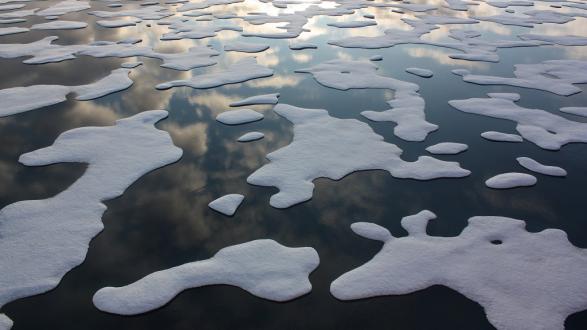Negotiators at this year’s climate summit are charged with forging consensus on how to implement the Paris Agreement. Paris represented an unprecedented accomplishment in climate diplomacy, but the work is far from over.
Diplomats from around the world have converged on Marrakesh in the Kingdom of Morocco for the next round of climate talks under the United Nations Framework Convention on Climate Change. This annual summit – called the Conference of the Parties, or simply COP – is the vehicle by which the Convention’s 197 parties (195 UN member states plus Palestine and the European Union) craft internationally binding rules to limit the destructive rise of global temperatures. This year’s COP (COP22) begins the lengthy and contentious process of negotiating how to implement the hard-won and ambitious mandate of last year’s Paris Agreement.
This is no mean task.
The Paris Agreement left many questions about implementation unanswered. That was by design. We can attribute it in part to the difficulty of achieving consensus in multilateral settings, even without the intense deadline pressure imposed on Paris by political leaders around the world. But it’s also because climate change is a monumental problem, and tackling it requires countries to make hard choices – and yes, sacrifices – about development priorities.
Those hard choices haven’t disappeared. The international community must now grind toward forging a consensus on how best to address what remains an existential threat to humanity.
Here are four key issues to watch for at COP22.
1. The Paris Agreement’s Early Entry into Force
The Paris Agreement is structured to enter into force 30 days after the "double threshold" is reached: ratification by at least 55 parties, accounting for at least 55 percent of global greenhouse-gas emissions.
The authors of the Paris Agreement assumed the world would cross these thresholds in time for the COP in 2018. Instead, the double threshold was met on October 5, 2016, when the EU, to great fanfare, deposited its ratification instruments with the UN Secretary General. This meant the Paris Agreement would enter into force fully two years ahead of schedule – in time for COP22.

A consequence of this happy news is that a new international body (the unfortunately named "Conference of the Parties serving as the meeting of the Parties to the Paris Agreement," but better known as the CMA) must convene for its first session in Marrakesh. Indeed, it is the CMA’s role to implement the Paris Agreement.
But the CMA’s birth is severely premature. The groundwork needed for the CMA to conduct its business – including the rules of procedure and functional mechanisms (or "modalities") – remain undeveloped. Further, if the CMA began its work now, a large number of signatories that have yet to complete their domestic ratification processes (most of them developing countries) would be excluded from participating.
In a sense, the Paris Agreement is a victim of its own success.
The question now is what to do with the embryonic CMA, since its meeting is obligatory and cannot be avoided. All indications are that the parties will convene the CMA and then "suspend" or "continue" its work until 2017 or 2018. But which year it commences its work (and what it does in the meantime) may yet be a source of considerable dispute. Some parties may see the CMA’s initial incapacity as an opportunity to relitigate issues settled in Paris. If that occurs, fighting over what to do with the CMA has the potential to overflow, derailing other key efforts on the agenda for COP22.
2. Defining Cycles of Ambition
In COP parlance, ambition represents the level of collective commitment toward mitigating global temperature rise. A key feature of the Paris Agreement is that it ratchets up ambition over time. This happens in several ways.
First, each party must submit a nationally determined contribution (NDC) every five years. An NDC represents the efforts a country commits to undertaking to address climate change, and especially how the country will mitigate emissions. The initial NDCs were submitted in Paris, and each NDC is to be successively more ambitious than the last.
Another part of the Paris Agreement’s ambition mechanism consists of various periodic evaluations of the progress of implementation. One example is the 2018 "facilitative dialogue" (technically mandated by a formal COP decision and not by Paris), which will also inform preparation for the next round of NDCs. Five years later, in 2023, is a "global stocktake," with subsequent stocktakes to be held every five years. This is the process by which the parties periodically assess their collective progress toward achieving Paris’s long-term goals.
So the Paris Agreement and the COP’s decision in Paris created several collective benchmarks to guide the development of increasingly ambitious NDCs by the parties. But the mechanics of these processes are yet to be worked out.
Specifically, the timelines of when parties should begin undertaking efforts toward these benchmarks ahead of the deadlines, and what those efforts should be, is unclear.
Presumably the parties should be preparing the technical and political groundwork well in advance of these periodic target dates so as to meaningfully contribute to (and benefit from) the process, but such preparation is beyond the text of Paris. It is featuring prominently in many conversations in Marrakesh.
3. Transparency as the Basis of Trust Among the Parties
If the NDCs and the ambition mechanism are to be effective in stemming global warming, the integrity of informational inputs and outputs to these processes is essential. It’s also essential to fostering accountability and trust. Many parties see transparency as the linchpin of the entire system.
This is especially so for wealthier countries who are expected to lead the way with financial support for developing countries under the Paris Agreement. They understandably want to know that financial flows will be properly (and honestly) spent, and they want to know that reporting on the efficacy of climate action accurately portrays results within beneficiary countries.
For their part, many developing countries appreciate the need for this kind of transparency, even as they harbor concerns about their capacity to deliver on some expectations under that rubric.
But Paris assumes that the transparency regime will apply without differentiation, regardless of national wealth. This is a moderate departure from the original Convention, which mentions transparency only in terms of finance from developed countries. Accurately assessing and reporting on environmental impacts, for instance, may not be as simple as an edict to just be "transparent." Building information gathering and reporting capacity in developing countries will be indispensable to achieving Paris’s aspiration of universal transparency.
Building information gathering and reporting capacity in developing countries will be indispensable to achieving Paris’s aspiration of universal transparency.
Further complicating this issue is how developing countries have sought to return to the Convention’s emphasis on transparency as an issue especially pertinent to rich countries’ financial commitments. That view holds that finance-providing countries should adopt concrete measures to ensure transparency in providing climate finance. Despite some claims of cynicism over this tack, developing countries have valid concerns about the nature and extent of wealthy financial commitments.
Determining and implementing a transparency regime that balances these interests is a fundamental challenge of the post-Paris world. Real solutions are likely to be highly technical, but the process will be frustrated if the negotiations bogged down in politics. Although transparency (and especially technical and procedural work to achieve it) does not arouse popular passions as other issues do, it will be a topic of considerable interest at COP22 and beyond.
4. Coordination with Work in Other International Forums
Both critics and boosters of the Paris Agreement often forget (or neglect to mention) that the COP, with its constellation of myriad subsidiary and ancillary bodies, is not the only workstream (a single word, in diplomat-speak) for international climate diplomacy. Critics point to the inadequacy of Paris alone to achieve the goals of the Convention (to say nothing of the more ambitious temperature goal in the Paris Agreement itself). Paris enthusiasts, on the other hand, sometimes focus on the importance of the Paris Agreement as a milestone without acknowledging that it doesn’t go far enough on its own.
The reality is that the international community has other vehicles for action on climate change. Those workstreams are increasingly siloed (that is, isolated from one another), which permits each track to move forward as it can without hobbling the others, but coordination still occurs. And important work is being done in these other forums.
For instance, the Kigali Amendment has given new life to the Montreal Protocol – an agreement originally intended to limit ozone-depleting chemicals – by repurposing the agreement to limit powerful greenhouse gases called HFCs.
The International Civil Aviation Organization (ICAO) has also reached an agreement to limit emissions from commercial air traffic. Although the initial phase of the ICAO agreement is voluntary, many countries have submitted their intent to treat that phase as mandatory.
With hard work and harder choices, we may yet always have Paris.
Both of these vital moves occurred within a week of the day when the Paris Agreement’s entry into force became fait accompli.
In yet another forum, the International Maritime Organization’s latest tier of shipping-emission regulations took effect in January of this year for North America and the Caribbean.
Critics, especially in the NGO and activist communities, look at these international efforts and (rightly) grumble that each step on its own is insufficient to the task at hand. But taken together, these moves reflect an understanding that coordinated action and holistic approaches to climate are essential to our achievement of Paris’s aspirations – and to our continued survival.
The COP is unlikely to go dabbling in the mandates of other forums in its formal decisions. But we can expect to see cross-references to other workstreams (often "without prejudice" to them) from subsidiary bodies, as well as continued civil-society focus on synthesizing and maximizing the interconnections.
In short, the parties at COP22 have an opportunity to continue toward meaningful climate action in the spirit of Paris. With hard work and harder choices, we may yet always have Paris. If we do, we will likely look back on this singularly perilous period in our history as the moment when we saved our planet for future generations.
____________________
Jesse Medlong is a Pacific Council member, lawyer, veteran, and member of the Truman Project Defense Council. Follow him on Twitter: @JCMedlong.
The views and opinions expressed here are those of the author and do not necessarily reflect the official policy or position of the Pacific Council.




